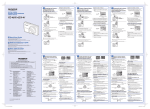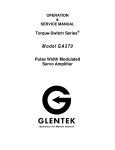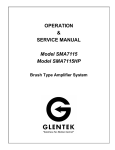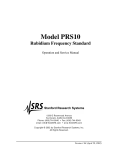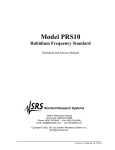Download OPERATION & SERVICE MANUAL Model GA369
Transcript
OPERATION & SERVICE MANUAL Model GA369 Pulse Width Modulated Servo Amplifier GA369 MANUAL TABLE OF CONTENTS TABLE OF CONTENTS CHAPTER ONE: INTRODUCTION 1.1 INTRODUCTION TO THE GA369 MANUAL ....................................................... 5 CHAPTER TWO: DESCRIPTION AND SPECIFICATIONS 2.1 DESCRIPTION OF THE GA369 ......................................................................... 6 2.2 AVAILABLE OPTIONS AND MODEL NUMBERING........................................... 6 2.2.1 2.2.2 2.2.3 2.2.4 2.2.5 2.2.6 2.2.7 2.3 2.3.1 2.3.2 2.3.3 SIGNAL INPUT ................................................................................................. VELOCITY MODE OR CURRENT MODE OPTIONS ........................................ + AND - LIMITS ................................................................................................. TOTAL INHIBIT ................................................................................................ CARRIER FREQUENCY .................................................................................. MULTI-AXES CONFIGURATIONS ................................................................... EXAMPLE - MODEL NUMBERING .................................................................... PROTECTION CIRCUITS................................................................................. DRIVE INHIBIT INDICATOR OPERATION (RED LED) ..................................... LOW SPEED ELECTRONIC CIRCUIT BREAKER (RED LED) .......................... HIGH SPEED ELECTRONIC CIRCUIT BREAKER (RED LED) ......................... 6 6 6 6 6 6 7 7 7 7 7 2.4 SPECIFICATIONS.............................................................................................. 7 2.4.1 2.4.2 2.4.3 2.4.4 2.4.5 2.4.6 OUTPUT POWER ............................................................................................ INPUT POWER ................................................................................................ SIGNAL INPUTS .............................................................................................. OTHER INPUTS AND OUTPUTS ..................................................................... MECHANICAL (ALSO SEE APPENDIXES B4-B7 AND Bi0-B13) ...................... TYPICAL FACTORY SETTINGS ...................................................................... 7 7 8 8 8 8 CHAPTER THREE: PERSONALITY PREAMP CARD 3.1 INTRODUCTION TO THE PERSONALITY PREAMP CARD (GA369-3) ............ 9 3.1.1 3.1.2 VELOCITY MODE PERSONALITY PREAMP CARD ........................................ 9 CURRENT MODE PERSONALITY PREAMP CARD......................................... 9 3.2 DESCRIPTION OF OPTIONS AND ADJUSTMENTS......................................... 9 3.2.1 3.2.2 POTENTIOMETER ADJUSTMENTS ................................................................ 9 INPUT AND OUTPUT SIGNALS...................................................................... 10 3.3 REMOVAL AND INSTALLATION ..................................................................... 10 3.4 TROUBLE SHOOTING WITH THE PERSONALITY PREAMP CARD .............. 10 CHAPTER FOUR: THEORY OF OPERATION 4.1 4.2 4.3 4.4 4.5 4.6 INTRODUCTION TO THEORY OF OPERATION ............................................. OPERATION OF OUTPUT SWITCHING TRANSISTORS................................ “H TYPE” OUTPUT BRIDGE CONFIGURATION ............................................. PULSE WIDTH MODULATION (PWM) ............................................................ CURRENT LOOP OPERATION ....................................................................... VELOCITY LOOP OPERATION ....................................................................... 11 11 11 11 12 13 CHAPTER FIVE: INSTALLATION PROCEDURE 5.1 MOUNTING ...................................................................................................... 14 5.2 WIRING SIZE AND PROPER TECHNIQUE ..................................................... 14 5.3 BASEPLATE CONNECTIONS ......................................................................... 14 5.3.1 INPUT FROM SECONDARY OF POWER TRANSFORMER ........................... 14 5.4 AMPLIFIER MODULE CONNECTIONS AND FUNCTIONS ............................. 14 5.4.1 5.4.2 5.4.3 5.4.4 5.4.5 D.C. BUSS ...................................................................................................... 14 MOTOR........................................................................................................... 15 SIGNAL INPUT ................................................................................................ 15 TACHOMETER INPUT .................................................................................... 15 CURRENT SENSE .......................................................................................... 15 Glentek Inc. 208 Standard Street, El Segundo, California 90245, U.S.A. (310) 322-3026 3 GA369 MANUAL 5.4.6 5.4.7 5.4.8 5.4.9 TABLE OF CONTENTS + AND - LIMITS............................................................................................... TOTAL INHIBIT ............................................................................................... FAULT MONITOR ........................................................................................... RESET ............................................................................................................ 15 15 15 15 CHAPTER SIX: START UP AND ADJUSTMENT PROCEDURE 6.1 6.2 6.3 6.4 6.5 SAFETY PRECAUTIONS ................................................................................. AMPLIFIER ALIGNMENT INTRODUCTION ..................................................... VELOCITY LOOP PHASING ............................................................................ TACH GAIN ADJUSTMENT.............................................................................. CONNECTING AMPLIFIER TO DIGITAL POSITION LOOP ............................. 16 16 16 16 17 CHAPTER SEVEN: MAINTENANCE, REPAIR AND WARRANTY 7.1 MAINTENANCE INTRODUCTION .................................................................... 19 7.2 REPAIR ............................................................................................................ 19 7.2.1 7.2.2 7.2.3 7.2.4 7.2.5 FAULT TRACING ............................................................................................ FAULT TRACING CHARTS ............................................................................. PART REPLACEMENT ................................................................................... LOW SPEED ELECTRONIC CIRCUIT BREAKER (LS/ECB) SHUTDOWN ...... HIGH SPEED ELECTRONIC CIRCUIT BREAKER (HS/ECB) SHUTDOWN..... 19 19 19 19 19 7.3 FACTORY REPAIR .......................................................................................... 20 7.4 WARRANTY ..................................................................................................... 20 APPENDIX A: FAULT TRACING CHARTS FAULT CHART 1 FAULT CHART 2 FAULT CHART 3 FAULT CHART 4 Motor does not turn in either direction ........................................ Motor only turns in one direction ................................................ Motor wanders and hunts or does not track smoothly ................ Motor does not develop maximum output speed (no load applied) in either direction ............................................ FAULT CHART 5 Motor does not develop max output torque in either direction .... ENGINEERING NOTES FOR FAULT TRACING CHARTS ....................................... 22 23 23 24 25 26 APPENDIX B: AMPLIFIER DRAWINGS INSTALLATION SCHEMATIC (GA369) (369-1007).................................................. ASSEMBLY CONTROL BOARD (GA369-1) (369-1002)........................................... INSTALLATION DIAGRAM (GA369-1) (369-1008) ................................................... INSTALLATION DIAGRAM (GA369-2A-2) (369-1205) ............................................. INSTALLATION DIAGRAM (GA369-4A-4) (369-1207) ............................................. INSTALLATION DIAGRAM (GA369-6A-6) (369-1211) ............................................. INSTALLATION DIAGRAM (GA369-8A-8) (369-1209) ............................................. - - - - - 28 29 30 31 32 33 34 APPENDIX C: PERSONALITY PREAMP SCHEMATIC PERSONALITY PREAMP (369-1200) ................................................. 36 ASSEMBLY PERSONALITY PREAMP (369-1202) ................................................... 37 4 Glentek Inc. 208 Standard Street, El Segundo, California 90245, U.S.A. (310) 322-3026 GA369 MANUAL CHAPTER ONE: INTRODUCTION INTRODUCTION 1.1 INTRODUCTION TO THE GA369 MANUAL: This manual is intended for use with Glentek’s TORQUE-SWlTCHTM series, model GA369 Pulse-Width-Modulated (PWM) servo amplifiers. It provides all of the information that is required for installation, alignment and maintenance of the GA369. We suggest that you take the time to read this manual from cover to cover before trying to work with a GA369 amplifier. If you have any questions that you can not find the answer to in this manual please feel free to call and discuss your problem or question with a Glentek applications engineer. Having been in the servo system business for over 26 years, we have a vast pool of applications knowledge waiting to help you. Thank you for using Glentek’s products. It is our goal to save you money, time and provide you with a superior product. Glentek Inc. 208 Standard Street, El Segundo, California 90245, U.S.A. (310) 322-3026 5 GA369 MANUAL CHAPTER 2: DESCRIPTION, FEATURES AND SPECIFICATIONS CHAPTER TWO: DESCRIPTION, AND SPECIFICATIONS 2.1 DESCRIPTION OF THE GA369: The GA369 are modular, high power, high bandwidth PWM servo amplifiers designed for use with DC permanent magnet servomotors. The GA369 utilize todays latest technology in power semiconductors for high efficiency which in turn makes the amplifiers extremely reliable in today’s and tomorrow’s demanding applications. 2.2 DESCRIPTION OF AVAILABLE OPTIONS AND MODEL NUMBERING INFORMATION: 2.2.1 SIGNAL INPUT: The GA369 is available with two signal inputs, one single-ended and one differential. The differential input is marked Aux. and Aux. Ret. and may be connected single ended by grounding Aux. Ret. (Refer to Appendix C, drawings 369-1200 and 369-1202). 2.2.2 VELOCITY MODE OR CURRENT MODE OPTIONS: The GA369 are most often used to close a critically damped velocity loop using a DC tachometer for velocity feedback. However, this high gain input summing amplifier can be bypassed providing an input directly to the current loop amplifier. The part number designator for this Current Mode option is CM and follows next in the sequence of part number (Ex. :GA369CM). If the CM is absent from the part number, the amplifier will be configured for Velocity Mode (Refer to Appendix C, drawings 369-1200 or 369-1202). 2.2.3 + AND - LIMITS: The GA369 may be configured for three different end of travel limit circuits with pull-up resistors (4.7k) to either + 5VDC or +1 5VDC. (Refer to Appendix C, drawing 369-1200) Type A: Requires grounding of pin 8 or pin 9 to disable amplifier. To implement type A limits refer to appendix B, drawing 369-1200. Type B: Requires a positive voltage at pin 8 or pin 9 to disable amplifier. To implement type B limits refer to Appendix B, drawing 369-1200. Type C: Requires the removal of a ground from pin 8 or pin 9 to disable amplifier. To implement type C limits refer to Appendix B, drawing 369-1200. The amplifier is normally shipped with the type A + and - limit configuration with +1 5V pull-up resistors. Designation letter A, B or C is added next to the part number to indicate type of limit circuit desired (Ex. : GA369CMA-1, would have type A limits). 2.2.4 TOTAL INHIBIT: The GA369 may be configured for three different Total Inhibit circuits (See 2.2.3 + AND - LIMITS above and refer to drawing 369-1200). The amplifier is normally shipped with type A Total Inhibit. 2.2.5 CARRIER FREQUENCY: The GA369 is provided with a carrier frequency of 10 KHz. Other carrier frequencies are available consult Glentek. 2.2.6 MULTI-AXES CONFIGURATIONS: The single and multi-axes part number designators are as follows: GA369-1 GA369-2A-1 GA369-2A-2 GA369-4A-3 GA369-4A-4 GA369-6A-5 GA369-6A-6 6 Single amplifier module. 2 Axes chassis with 1 Amplifier module. 2 Axes chassis with 2 Amplifier modules. 4 Axes chassis with 3 Amplifier modules. 4 Axes chassis with 4 Amplifier modules. 6 Axes chassis with 5 Amplifier modules. 6 Axes chassis with 6 Amplifier modules. Glentek Inc. 208 Standard Street, El Segundo, California 90245, U.S.A. (310) 322-3026 GA369 MANUAL 2.2.7 CHAPTER 2: DESCRIPTION, FEATURES AND SPECIFICATIONS EXAMPLE MODEL NUMBERING: - The following example of GA369 part numbering, is provided to help you better understand Glentek’s part numbering system: Example: GA369CMA-4A-3 In this example, the GA369 part number describes the following amplifier configuration: CM = Current Mode input option A Type A + and - Limit option. -4A = 4 Axes chassis -3 = 3 Amplifier modules installed. For this example each of the three amplifier modules would be labeled GA369-1 or GA369-1 with serial number and CMA designator at bottom of label. The 4 axes chassis would be labeled GA369-4A-3 with serial number and CMA designator at bottom of label. 2.3 PROTECTION CIRCUITS: The following protection circuits are integral to the GA369 amplifiers to prevent damage to the amplifier and your equipment. Again, Glentek is anxious to work with you in helping to implement any circuit functions your system might require. Note: For 2.3.1 to 2.3.3 refer to Appendix B, drawing 369-1007. 2.3.1 DRIVE INHIBIT INDICATOR OPERATION (RED LED): The LED 1 Drive Inhibit indicator light will turn ON and latch for the two following conditions: 1. Low Speed Electronic Circuit Breaker (LS/ECB) triggered. 2. High Speed Electronic Circuit Breaker (HS/ECB) triggered. 2.3.2 LOW SPEED ELECTRONIC CIRCUIT BREAKER: This circuit protects the motor, amplifier and mechanical system from damage due to excessive mechanical bind in the system or possibly driving into a hard mechanical stop. Circuit operation is as follows: When the motor current exceeds the value set at TP1, typically 3.0 VDC (scale factor 1 VOLT=2 AMPS), IQ3-1 switches positive and voltage on C5 begins integrating up. If the current remains above the set point, typically 0.5 seconds, Q9 will trigger the ECB latch and the Drive Inhibited indicator. 2.3.3 HIGH SPEED ELECTRONIC CIRCUIT BREAKER: This circuit protects the amplifier from dead shorts across the amplifier output terminals. The HS/ECB is always factory set and should not be adjusted. The typical factory setting is 29 Amps for 10 micro seconds. Again, this circuit triggers the ECB latch and the Drive Inhibited indicator. 2.4 SPECIFICATIONS: The specifications for each GA369 amplifier module is as follows: 2.4.1 OUTPUT POWER OUTPUT CURRENT (PEAK): ±12 AMPS OUTPUT CURRENT (RMS): ±6 AMPS DC BUSS VOLTAGE: +35VDCTO +7OVDC (Higher and lower Buss Voltages available, consult Glentek.) Note: DC Buss voltage should be selected approximately 10%-20% above the maximum voltage required at motor terminals for maximum system efficiency. 2.4.2 INPUT POWER: INPUT POWER FOR DC BUSS: A fused single or three phase full wave rectifier and filter capacitor are provided on the base plate. The AC input to this circuit is supplied by a separately mounted power transformer unique to the application. The power transformer and motor output inductors are not standard parts of the amplifier package. Glentek has power transformers and inductors in stock for your system requirements. Glentek Inc. 208 Standard Street, El Segundo, California 90245, U.S.A. (310) 322-3026 7 GA369 MANUAL 2.4.3 CHAPTER 2: DESCRIPTION, FEATURES AND SPECIFICATIONS SIGNAL INPUTS: VOLTAGE,MAXIMUM Aux. Input Sig. Input Tach. Input Input Impedance, Minimum ±13 Volts ±70 Volts ±90 Volts 10K Ohm GAIN,MAXIMUM Sig. and Aux. Inputs Tachometer Drift (Ref. to Input), Maximum Frequency Response, Minimum Dead Band Form Factor 15,000 Amps/Volt 7,000 Amps/Volt 0.01 mV/°C 750 Hz None 1.01 2.4.4 OTHER INPUTS AND OUTPUTS +and - Limits (Type “A’1) Total Inhibit (Type “A”) Gnd. to reset Fault Monitor Activated by a 3ma. contact closure to common. Activated by a 3ma. contact closure to common. Activated by a 3ma. contact closure to common. 4.7k ohm pull-up to +5VDC or + 15VDC ,will sink 50 ma. 2.4.5 MECHANICAL (SEE APPENDIXES B4-B7) Mounting Height Cooling Any Position 7 inches 50°C Ambient Max. Baseplate GA369-2A-2 GA369-4A-4 GA369-6A-6 6.25 in. x 8.8 in. 6.25 in. x 12.2 in. 6.25 in. x 19.0 in. Weight GA369-1 GA369-2A-2 GA369-4A-4 GA369-6A-6 1.14 lbs. 5.1 lbs. 7.5 lbs. 9.5 lbs. 2.4.6 TYPICAL FACTORY SETTINGS Sig. and Aux. Gain Tach. Gain Loop Gain Comp. LS/ECB HS/ECB 8 5V(Sig.)/7V(Tach.) 50% CCW (OFF) CW (Mm. Bandwidth) 6A @ 0.5 sec. 29A ~ 10 micro sec. Glentek Inc. 208 Standard Street, El Segundo, California 90245, U.S.A. (310) 322-3026 GA369 MANUAL CHAPTER 3: PERSONALITY PREAMP CARD CHAPTER THREE: PERSONALITY PREAMP CARD 3.1 INTRODUCTION TO THE PERSONALITY PREAMP CARD (GA369-3): The Personality Preamp card is a modular plug-in card that comes in two versions: velocity mode and current mode. Schematic and Board Assembly prints for this card are found in Appendix C, drawing numbers 369-1200, 369-1202 and will be referred to in the following description. The Personality card contains the main high gain preamp with all associated system alignment adjustments. This card greatly enhances system troubleshooting and repair; in that if an amplifier should fail, simply remove the Personality card (which has all of the original system constants adjusted in) and replace it on a spare amplifier. This eliminates system realignment when changing out amplifiers. Also, a motor-tach-load may be aligned at the factory and then just the Personality card sent to the field for system test. 3.1.1 VELOCITY MODE PERSONALITY PREAMP CARD: The Velocity Mode Preamp Card contains the main high gain preamp with all the associated system alignment adjustments to close a velocity loop using a D.C. tachometer for velocity feedback. (Refer to Appendix C, drawings 369-1200 and 369-1202) 3.1.2 CURRENT MODE PERSONALITY PREAMP CARD: The Current Mode Personality Card contains all the system alignment adjustments to control a current mode amplifier. (Refer to Appendix C, drawings 369-1200 and 369-1202) 3.2 DESCRIPTION OF OPTIONS AND ADJUSTMENTS: The Personality Preamp card is a small printed circuit card (3.3” x 4.3”) standing on two 12 pin connectors (0.45” tall) that mate with appropriate sockets on the amplifier control board. The Personality card is most often used to close a velocity loop using a DC tachometer for velocity feedback. However, the high gain input summing amplifier can be bypassed providing an input directly to the current loop amplifier (Current Mode option). If the Current Mode (CM) option is specified the Velocity Mode Personality Preamp Card is converted to a Current Mode Personality Preamp Card. (Refer to Appendix C, drawings 369-1200 and 3691202) 3.2.1 POTENTIOMETER ADJUSTMENTS: The following is a description of the potentiometer adjustments used for the two modes of operation. Please refer to Chapter Six on Start Up and Adjustment Procedures for a detailed description of how to set these potentiometers. VELOCITY MODE: (Refer to Appendix C, drawings 369-1200 and 369-1202) R15 Signal Gain potentiometer sets the input voltage to output RPM required by your system for the singleended input. (Ex.: 10 VOLTS INPUT = 2000 RPM) R45 Auxiliary Signal Gain potentiometer sets the input voltage to output RPM required by your system for the differential signal input (Ex.: 10 VOLTS INPUT = 2000 RPM). R21 Tachometer Gain potentiometer sets the amount of tach signal required by your system. Use in conjunction with the Compensation potentiometer, R16, to adjust the system bandwidth. R43 Balance potentiometer used to null out any DC offset in the amplifier (Ex.: 0 VDC INPUT = 0 RPM). R55 Compensation potentiometer sets the amount of bandwidth (frequency response) required by your system. Use in conjunction with the Tachometer Gain potentiometer, R14, to adjust the system bandwidth. R57 Current Limit potentiometer sets the maximum acceleration and deceleration current. R59 Loop Gain potentiometer used to reduce the velocity loop gain to zero when the system is first turned on to prevent run away operation. Before turning the system on for the first time this potentiometer is set fully CCW to command zero current to the motor. Once the system is correctly phased this potentiometer is set fully CW for all further system adjustments. CURRENT MODE: (Refer to Appendix C, drawings 369-1200 and 369-1202) Glentek Inc. 208 Standard Street, El Segundo, California 90245, U.S.A. (310) 322-3026 9 GA369 MANUAL CHAPTER 3: PERSONALITY PREAMP CARD R15 Signal Gain potentiometer sets the input voltage to output current required by your system for the singleended input. (Ex.: 5 VOLTS INPUT = 2 AMPS OUTPUT CURRENT) R45 Auxiliary Signal Gain potentiometer sets the input voltage to output RPM required by your system for the differential signal input (Ex.: 5 VOLTS INPUT = 2 AMPS OUTPUT CURRENT). R57 Current Limit potentiometer sets the maximum acceleration and deceleration current. R59 Loop Gain potentiometer is factory set to prevent amplifier maximum rated current from being exceeded when the current limit potentiometer is fully CW. R43 Balance potentiometer used to null out any DC offset in the amplifier. (Ex.: 0 VDC INPUT = 0 CURRENT OUTPUT) 3.2.2 INPUT AND OUTPUT SIGNALS: Connector P2 Pin No. (Signals to and from connector J1) 1 AUXILIARY Differential signal input. 2 AUXILIARY RETURN Differential signal input. 3 SIGNAL Single-ended signal input. 4 SIGNAL COMMON Signal common. 5 TACHOMETER Tachometer signal input. 6 TACHOMETER COMMON Signal common. 7 RESET Resets amplifier after a fault (input). 8 + LIMIT Inhibits motor rotation in the + direction (input). 9 -LIMIT Inhibits motor rotation in the - direction (input). 10 TOTAL INHIBIT Inhibits motor rotation in the both directions (input). 11 COMMON Signal common and ± 15 VDC common. 12 FAULT Fault monitor output. Connector P3 Pin No. (Signals to and from power board) 1 INHIBIT Total inhibit output. 2 CURRENT SIGNAL Velocity error or current command output. 3 CURRENT SENSE Current sense input. 4 + LIMIT + Limit output. 5 -LIMIT - Limit output. 6 +15VDC + 15VDC power. 7 COMMON ± 15 VDC and signal common. 8 COMMON ± 15 VDC and signal common. 9 COMMON ± 15 VDC and signal common. 10 -15 VDC - 15 VDC power. 11 FAULT Fault input. 12 RESET Reset output. 3.3 REMOVAL AND INSTALLATION: When removing or installing the Personality Preamp card, care must be taken not to damage any of the components under the card on the amplifier controller board or on the Personality card. Removal: Remove the retaining screw hold the Personality card by its edges and pull straight away from the amplifier controller board (Do not pull on the components). For amplifiers with Personality card mounted vertically, remove amplifier module first before unplugging Personality card. Installation: Hold the Personality card by it’s edges and carefully align the two 12 pin connectors with their mating sockets and push straight toward the amplifier controller board until it is firmly seated (Do not press on any of the components) and replace the retaining screw. 3.4 TROUBLE SHOOTING WITH THE PERSONALITY CARD: If your system exhibits a problem and a working amplifier module is available fault tracing can be expedited by removing the Personality Preamp card from the malfunctioning amplifier, plugging it into the replacement amplifier and testing the system. If the system does not work with the new amplifier module, Refer to Chapter Seven on Maintenance and Repair for a more detailed fault tracing procedure. However, if the system does work with the new amplifier module, check the malfunctioning unit for loose connections and retest the suspected unit in the system. 10 Glentek Inc. 208 Standard Street, El Segundo, California 90245, U.S.A. (310) 322-3026 GA369 MANUAL CHAPTER 4: THEORY OF OPERATION CHAPTER FOUR: THEORY OF OPERATION 4.1 INTRODUCTION TO THEORY OF OPERATION: A Velocity Mode servo amplifier is essentially comprised of two control loops (see fig. 4.1). Figure 4.1 Velocity mode sevo loop for a brush type motor The inside control loop is referred to as the Current Loop and the outside loop is referred to as the Velocity Loop. Before we begin our analysis of the Current Loop, let us review some basic concepts which will help you to better understand the amplifier’s operation. 4.2 OPERATION OF OUTPUT SWITCHING TRANSISTORS: The output transistors, for all intents and purposes, operate in only two states. They are analogous to an ON/OFF switch. When an output transistor is OFF, there is no current flowing through it (it’s resistance is infinite). When an output transistor is ON, current flows through it (it’s resistance is near zero). When the transistor is ON, it is technically referred to as being in saturation. 4.3 “H TYPE” OUTPUT BRIDGE CONFIGURATION: The output configuration of the amplifier is a “H TYPE” bridge (see fig. 4.2 for schematic representation of output bridge with motor connected). Figure 4.2 Schematic representation of an output bridge with a motor connected. The advantage of an “H TYPE” output bridge configuration is that by controlling the switching of the opposite pairs of transistors, current can be made to flow through the motor in either direction using a single polarity power supply as shown in figure 4.2. To provide motor current in one direction, A and C are turned ON, while B and D remain in the OFF state. To provide motor current in the other direction, B and 0 are turned ON, while A and C remain in the OFF state. 4.4 PULSE-WIDTH-MODULATION (PWM): Pulse-Width-Modulation is the technique used for switching opposite pairs of output transistors ON and OFF to control the motor drive current. When zero current is commanded to the current loop, the opposite pair of transistors are turned ON and OFF as shown in figure 4.3. Note that since the pulse widths are equal, the net DC current in the motor is equal to zero. Glentek Inc. 208 Standard Street, El Segundo, California 90245, U.S.A. (310) 322-3026 11 GA369 MANUAL CHAPTER 4: THEORY OF OPERATION Figure 4.3 Transistor switching waveform at zero current When a non-zero current is commanded to the current loop, the transistor switching waveform is as shown in figure 4.4A. Since there is a non-zero current command, the output transistor pulse widths will change and the motor will see a net DC current flowing from A through C (see fig. 4.3A). Figure 4.3A Transistor switching waveform when current flows from A through C If the input to the current loop had been changed in polarity, the output transistor switching waveform would be as shown in figure 4.3B. Figure 4.3B Transistor switching waveform when current flows from B through D If a larger current of the same polarity was commanded to the output transistors (see fig. 4.3B), the ON time widths of B and 0 would automatically increase to provide more current. From the previous examples it is easy to understand why this output transistor switching technique is referred to as Pulse-Width-Modulation. To change the magnitude and polarity of the current flow in the motor, the pulse widths of the opposite pairs of transistors are modulated. The frequency at which these output transistors are switched ON and OFF is referred to as the Carrier Frequency. After realizing how the PWM amplifier output works, it becomes apparent that some inductance must be added to the motor circuit to prevent excessively high AC current ripple and heating in the servomotor. Consult a Glentek applications engineer for recommended inductance. Now that we have a good understanding of how the current is provided from an “H TYPE” Pulse-Width-Modulated (PWM) bridge, let’s analyze the operation of the current loop. 4.5 CURRENT LOOP OPERATION: Please refer to figure 4.1 for a diagram of the Current Loop. In control electronics the symbol sigma (with the circle around it) is referred to as a Summing Junction. The manner in which this summing junction operates is as follows: The Current Command Signal (also referred to as the Velocity Error Signal when received from the output of the velocity loop, as shown in fig. 4.1) is added to the current feedback signal. The signal resulting from this addition, is referred to as the Current Error Signal. This current error signal is fed into the current amplifier, which in turn produces a current in the motor. A voltage which is proportional to the motor current is developed across Rs (shunt resistor), this voltage is referred to as the Current Feedback Signal. The current in the motor increases until the current feedback signal is exactly equal in magnitude, but opposite in polarity, to the current command signal. At this point the current error signal drops to zero, and the commanded current is equal to the actual current. If anything happens to disturb either the current command signal, or the current feedback signal, the same process occurs again until the current command signal is equal in magnitude to the current feedback signal, but opposite in polarity. 12 Glentek Inc. 208 Standard Street, El Segundo, California 90245, U.S.A. (310) 322-3026 GA369 MANUAL CHAPTER 4: THEORY OF OPERATION The type of loop described above is referred to as a Servo Loop because the current servos about a commanded value. We are surrounded in our everyday lives by a multitude of servo loops. For example, many of today’s luxury cars have what is called “automatic climate control”. To operate this servo loop you set the climate control to the temperature that you wish to be maintained in the interior of the car (current command signal). The selected temperature is then summed with the actual temperature from a thermometer (current feedback), and the output (current error signal) activates either the heater or the air-conditioner until the set temperature (current command signal) is equal in magnitude, but opposite in polarity, to the actual temperature as measured by the thermometer (current feedback). 4.6 VELOCITY LOOP OPERATION: Please refer to figure 4.1 for a diagram of a typical Velocity Loop. The velocity loop’s operational description is analogous to the current loop description, except for the fact that the input signal is called the Velocity Command and the feedback signal from the DC tachometer is called the Velocity Feedback. Glentek Inc. 208 Standard Street, El Segundo, California 90245, U.S.A. (310) 322-3026 13 GA369 MANUAL CHAPTER 5: INSTALLATION PROCEDURE CHAPTER FIVE: INSTALLATION PROCEDURE 5.1 MOUNTING: The installation diagrams in Appendix B show the bolthole mounting pattern to support the amplifier. The mounting holes will accept a 1/4-inch bolt. The base material is cadmium plated .060 inch thick steel. THE MOUNTING BOLT SHOULD PROVIDE AN ELECTRICAL GROUND FOR THE CHASSIS TO MINIMIZE SHOCK HAZARD. The surface that the amplifier package will be mounted on must be able to support its weight, but does not need to provide “cold plate” cooling for the amplifier. It is recommended to allow a minimum of one inch clearance from any side and the top of the amplifier to the cabinet wall for air circulation, wire routing and terminal strip access. The amplifier package should be mounted in a clean, dry enclosure with a maximum ambient temperature of 500C. To ensure maximum reliability, keep the amplifier cabinet cool and free from dust, oil and other contaminates. NEVER INSTALL THE AMPLIFIER PACKAGE IN ANY LOCATION WHERE FLAMMABLE OR EXPLOSIVE VAPORS ARE PRESENT 5.2 WIRING SIZE AND PROPER TECHNIQUE: Please refer to Appendix B, GA369 installation diagrams. These installation diagrams show the necessary external connections to ensure proper amplifier operation. Glentek recommends that your wiring be in accordance with all national and local codes that are applicable to your system. Wire size must be sufficient to accommodate the maximum continuous current that will be run thru it. Recommended wire sizes for the GA369 are as follows: MOTOR ARMATURE -14 ga. 0-105 VAC POWER INPUT (from secondary of power transformer) - 14 ga. 120 VAC FOR FANS - 16 ga. twisted pair. SIGNAL INPUT - 22 ga. mm. 2 conductor with shield. TACHOMETER INPUT - 22 ga. mm. 2 conductor with shield. Terminate shield, one end only at tachometer common TB1 terminal 6 of amplifier module. When wiring to and from the drive cabinet, it is considered good technique to route the power lines (16 ga. and larger) along different paths than the signal and tachometer lines. This minimizes the amount of stray noise and pick-up that is injected into the amplifier. 5.3 BASEPLATE CONNECTIONS: 5.3.1 INPUT FROM SECONDARY OF POWER TRANSFORMER: The AC voltage that is used to form the DC Buss of the amplifier package, is supplied from a separately mounted transformer that has been selected by Glentek for your application. Connect the secondary of the power transformer to terminals 2 and 3 of TB2O1 on systems with a single phase input, and to terminals 1, 2 and 3 of TB2O1 on systems with a three phase input. DO NOT APPLY ANY POWER YET. 5.4 AMPLIFIER CONNECTIONS AND FUNCTIONS: 5.4.1 DC BUSS: The DC Buss, from the filter capacitor is connected to terminals 1 (+) and 2 (-) of terminal strip TB1. This connection is already made for you on our multiaxes packages. The power transformer for the DC Buss is not a standard part of the amplifier package. Glentek can advise on transformer specifications required. Most styles and sizes are in stock at Glentek. 14 Glentek Inc. 208 Standard Street, El Segundo, California 90245, U.S.A. (310) 322-3026 GA369 MANUAL 5.4.2 CHAPTER 5: INSTALLATION PROCEDURE MOTOR: The Motor is connected to terminals 3(-) and 4(+) of terminal strip TB1 of the amplifier module (SEE APPENDIXES B4-B7). In most cases, if the motor inductance is less than 1 millihenry, an inductor should be connected in series with the motor leads. The inductor is considered to be a separate part from the amplifier package. Glentek can advise on the inductor specifications, and most styles and sizes are in stock at Glentek. IT IS IMPERATIVE THAT YOU DO NOT USE GROUNDED TEST EQUIPMENT ON THE MOTOR ARMATURE NOR CONNECT EITHER END OF THE MOTOR ARMATURE TO SIGNAL GROUND OR DC BUSS RETURN. 5.4.3 SIGNAL INPUT: The amplifier has two Signal Inputs, one single-ended (Signal Input J1-3) and one differential (Auxiliary Signal Input J1-1, Auxiliary Return J1-2). Please refer to Chapter 2.2 for options and model numbering information. Typically when operating in the velocity mode, the input signal range is ± 10 VDC. The input voltage is summed with a precision DC tachometer to provide accurate velocity control at the servo motor shaft (see fig. 4.1). The Signal Gain potentiometer (10 K ohm), R15, and Auxiliary Gain potentiometer, R45, adjust the motor velocity desired for a given input voltage velocity command. 5.4.4 TACHOMETER INPUT: The Tachometer is connected to terminals 5 and 6 of terminal strip J1 of the amplifier module (see 5.2 for recommended wire type & size). 5.4.5 CURRENT SENSE: The Current Sense output signal can be monitored at TP 7 on the preamp card (see appendix C, drawings 369-1200 and 369-1202). It is an isolated output signal that is proportional to motor current. The scale factor is 1 VOLT = 2 AMPS. 5.4.6 + AND - LIMITS: The + and - Limits are located respectively at terminals 8 and 9 of terminal strip J1 of the amplifier module. Please refer to 2.2.3 for a description of the different configurations of limits that are available. Amplifier modules are normally shipped with type “A” limits when terminals (J1-8 or J1-9) are pulled to ground (J1-11) by some external circuit the amplifier is inhibited in the + or - direction. 5.4.7 TOTAL INHIBIT: The Total Inhibit is located at terminal 10 of terminal strip J1 of the amplifier module. Please refer to 2.2.3 for a description of the different configurations of Total Inhibit that are available. Amplifier modules are normally shipped with type “A” Total Inhibit [when terminal (J1-10) is pulled to ground (J1-11) by some external circuit the amplifier is totally inhibited]. 5.4.8 FAULT MONITOR: The Fault Monitor is located at terminal 12 of terminal strip J1 of the amplifier module. The amplifier will pull this terminal to ground by turning ON 01 for the following fault conditions: 1. Low Speed Electronic Circuit Breaker (LS/ECB) triggered. 2. High Speed Electronic Circuit Breaker (HS/ECB) triggered. NOTE: Please refer to Chapter 2.3 on Protection Circuits for a more detailed description of the possible conditions that will cause the above faults to occur. 5.4.9 RESET: The amplifier can be reset two ways, by grounding the RESET input (J1-7) with a 3ma. contact closure to amplifier common (J1-11) for 1 ms. minimum, or by removing all power and waiting for the buss capacitors to discharge and reapplying power. (Refer to appendix B, drawing 369-1007 or appendix C, drawing 369-1200) Glentek Inc. 208 Standard Street, El Segundo, California 90245, U.S.A. (310) 322-3026 15 GA369 MANUAL CHAPTER 6: START UP AND ADJUSTMENT PROCEDURE CHAPTER SIX: START UP AND ADJUSTMENT PROCEDURE 6.1 SAFETY PRECAUTIONS: Before starting the adjustment and alignment procedure please be sure to observe the following precautions: 1. Be certain that there are no visibly loose or damaged components. 2. Check that all connections are tight. 3. Check all power and signal wiring. Remove power input fuses, apply power and measure that correct power voltage is being applied. Your DC Buss voltage will be 1.4 x the AC power applied (Refer to Appendix A, note 1). 4. Be sure that the motor mechanism is clear of all obstructions. If motor is connected to an axis lead screw or other device with limited motion, place at midposition. 5. Work on only one amplifier at a time. 6. Make sure all Loop Gain pots are turned fully CCW before applying power. 7. DO NOT use grounded test equipment. 6.2 AMPLIFIER ALIGNMENT INTRODUCTION: When adjusting an amplifier for optimum velocity loop operation it is desirable to achieve a critically damped, stable step velocity response with maximum DC Tach Gain. The following discussion will describe how to best achieve this result: Your amplifier has been run at the factory with a known motor, tachometer and inertial load. In testing at the factory we try to simulate the same conditions you will have in your system. For this reason it is a good idea to start with the initial settings as shipped from the factory. NOTE: All of the following adjustments are to be made on the Personality Preamp card (Refer to Appendix C, drawings 369-1200 & 369-1202). 6.3 VELOCITY LOOP PHASING: For proper servo operation it is necessary for the amplifier to receive negative feedback from the tachometer. If the tachometer leads are reversed (positive feedback), the amplifier will run away. To check the phasing of the motor and tachometer proceed as follows: 1. Make sure Loop Gain potentiometer, R59, is full CCW (as shipped from factory). 2. Make sure that nothing is connected to the Signal Input (J1-3) or the Auxiliary Signal Input (J1-1 or J1-2). 3. Apply the main power. 4. Slowly turn the Loop Gain potentiometer, R59, CW. If the motor starts to run away turn the Loop Gain potentiometer full CCW and reverse the motor armature leads. Again, turn the Loop Gain potentiometer CW. The motor should be stopped or rotating slowly. 5. Leave Loop Gain potentiometer, R59, full CW for all remaining adjustments and operations. 6.4 TACH GAIN ADJUSTMENT: 1. At this point the motor will be rotating slowly. Adjust the Balance potentiometer,R43, until the motor rotation is stopped. 2. While observing the tachometer output voltage with an oscilloscope, apply a step input voltage at the Signal Input terminal of the amplifier. A step input voltage can be simulated by applying and removing a flashlight battery to the Signal Input. For this purpose the battery is usually mounted inside of a small box with a switch. Common names used to describe this DC signal voltage source are Battery Box or DC Simulator. Elaborate signal sources are often made for this purpose including bipolar output, potentiometer output adjust and polarity reversing switches, etc. You often hear the term “DC Box the velocity loop servo” being used by people working on servo systems. (This Signal Box may be purchased from Glentek Inc., Part Number BB700) 16 Glentek Inc. 208 Standard Street, El Segundo, California 90245, U.S.A. (310) 322-3026 GA369 MANUAL CHAPTER 6: START UP AND ADJUSTMENT PROCEDURE 3. At this point the motor should be running smoothly. While applying and removing the DC input signal adjust the Current Limit potentiometer, R57, for desired maximum acceleration and deceleration current. Motor current should be observed by using an oscilloscope at TP-7. Scale factor of voltage at this point is 1 VOLT = 2 AMPS of motor current. Leave the Current Limit potentiometer at this setting for all remaining adjustments. 4. Adjust the Signal Gain potentiometer, R15 or R45, of the signal input that you are using so when you apply the DC signal the motor rotates at approximately 400 RPM. 5. Observe the tachometer voltage with an oscilloscope while applying and removing the DC input signal. You will observe one of three possible waveforms; Critically Damped, Under Damped or Over Damped (see figure 6.4). 6. The waveform that for many systems is optimum is the critically damped waveform. If the waveform that you are observing is critically damped proceed to step 9. 7. If your waveform is under damped make the following adjustments: Turn the Compensation potentiometer, R55, CCW until the waveform becomes critically damped. Note here that the limiting factor will be a motor oscillation, you must always leave the Compensation potentiometer CW enough so that the velocity loop remains stable. If the waveform is still under damped after adjusting the Compensation potentiometer for maximum bandwidth, turn the Tachometer Gain potentiometer, R21, 2 turns CCW and then again adjust Compensation potentiometer, R55, CCW until waveform becomes critically damped. Repeat procedure if necessary. Again, the servo velocity loop must at all times remain stable. Consult the factory if necessary. 8. If the waveform is over damped make the following adjustments: Turn the Tachometer Gain potentiometer, R21, CW until a slight overshoot appears on the waveform then turn the Compensation potentiometer, R55, CCW until a critically damped waveform is observed. 9. Now that the waveform is critically damped, leave the Compensation, R55, and Tachometer Gain, R21, at these settings for all remaining adjustments and operations. 10. Next set the Signal potentiometer, R15 or R45, of the signal input that you are using to the gain required by your system (Ex.: 10 VOLTS INPUT = 2000 RPM). 11. Adjust Balance potentiometer, R43, one more time to null out any offset. 12. For all remaining adjustments when placing the amplifier in your system only the Signal potentiometer, R15 or R45, and Balance potentiometer, R43, should be adjusted. Figure 6.4 6.5 CONNECTING AMPLIFIER TO DIGITAL POSITION LOOP: Before connecting the amplifier to the Digital Position Loop, be sure adjustments of section 6.4 have been made. Start out with Loop Gain potentiometer, R18, fully CCW and activate the Digital Position Loop. Slowly turn loop Gain potentiometer CW. If servo runs away, immediately adjust Loop Gain fully CCW and turn power OFF. Glentek Inc. 208 Standard Street, El Segundo, California 90245, U.S.A. (310) 322-3026 17 GA369 MANUAL CHAPTER 6: START UP AND ADJUSTMENT PROCEDURE 1. It is possible, at this time, that the Digital Loop is reverse phased. An example of this would be if a positive voltage from the velocity DAC required the motor to turn CW, however, it turned CCW instead causing the encoder feedback signal to count up instead of down. This would cause a run away condition. If you are out of phase as described, be sure power is OFF and reverse the motor leads at the amplifier and also the tachometer leads. This will cause the motor to rotate in the opposite direction as it did before, properly phasing the Digital Loop. 2. Now with the Digital Loop operating, turn the Loop Gain potentiometer, R1B, fully CW and command a small move. Slowly increase or decrease the Signal Gain potentiometer, R12 or R13, of the amplifier until the servo is operating as required. It should be noted here that too much Signal Gain at this point could cause instability (oscillation). Do not stay in this oscillating condition long as it may result in system mechanical or electrical damage. Be sure when all signal adjustments are made that the balance is rechecked and adjusted for zero rotation for zero signal input. 3. It should be noted here that the GA369 are designed to operate with many different systems and if after reading this manual you have further questions, do not hesitate to call a Glentek applications engineer. ENGINEERING NOTE: After all systems are aligned and functioning it is good practice to remove power from the amplifier and, using a digital ohm-meter, measure the impedance value of the following potentiometer wiper settings with respect to signal ground. These values may be useful for the next machine you align or for maintenance of this system at a later date. Make these measurements on each amplifier on a multiaxis baseplate. Record resistance measurements: AMP 1 AMP 2 AMP 3 AMP 4 AMP 5 AMP 6 Signal voltage Tachometer voltage ——— ——— ——— ——— ——— ——— Date Taken: Note any changes to compensation components, etc.: Tach. potentiometer wiper to signal ground. (ohms): Signal potentiometer wiper to signal ground. (ohms): Comp. potentiometer wiper to signalground. (ohms): Current limit potentiometer wiper to signal ground (ohms): 18 ____ ____ ____ Glentek Inc. 208 Standard Street, El Segundo, California 90245, U.S.A. (310) 322-3026 GA369 MANUAL CHAPTER 7: MAINTENANCE, REPAIR AND WARRANTY CHAPTER SEVEN: MAINTENANCE, REPAIR AND WARRANTY 7.1 MAINTENANCE: The GA369 amplifiers do not require any scheduled maintenance. 7.2 REPAIR: If your system exhibits a problem, this manual should assist you to identify the fault and to replace the defective component or sub-assembly. The GA369 amplifiers are modular assemblies and each individual amplifier section is designed to be easily removed and replaced at the field level. It is Glentek’s recommendation that a failed amplifier module be replaced in the field and returned to Glentek for failure analysis and repair. However, Appendixes B and C contain complete system schematics that, in case of extreme emergency, should permit a skilled electronic technician to trouble shoot the circuit boards to levels lower than those recommended as replaceable. 7.2.1 FAULT TRACING: This section will aid in the location of defective replaceable components and assemblies. A list of the fault tracing charts in Appendix A, along with the observable fault follows: Fault Chart 1 Motor does not turn in either direction. Fault Chart 2 Motor only turns in one direction. Fault Chart 3 Motor wanders and hunts or does not track smoothly. Fault Chart 4 Motor does not develop maximum output speed (no load applied) in either direction. Fault Chart 5 Motor does not develop maximum output torque in either direction. 7.2.2 FAULT TRACING CHARTS: The fault tracing charts in Appendix A start with an observable fault listed at the top of each chart. Follow the line connections between blocks by your answers to the questions noted in the diamond shape blocks until the defective part is isolated. The charts are to be used only as a guide to identify the parts or assemblies that Glentek recommends as the lowest level of repair. The fault tracing procedures assume that only a single failure mode exists. 7.2.3 PART REPLACEMENT: The removal and replacement of the defective assembly can be accomplished with standard shop procedures. The assemblies that may be easily removed are as follows: 1. Fuses F201-F202 on baseplate and Fl on each amplifier module. 2. Rectifier BR2O1 and BR202. 3. Capacitor C201, C202. 4. Amplifier Module A1-A8. After reviewing the fault tracing charts you may conclude that the complete amplifier should be returned to Glentek for failure analysis, repair and retesting to specifications. This is particularly true with failure modes in the amplifier module sections Al thru A8. 7.2.4 LOW SPEED ELECTRONIC CIRCUIT BREAKER (LS/ECB) SHUTDOWN: The LS/ECB is tripped when a preset current threshold is exceeded for a preset length of time, typically 6 Amps for 0.5 seconds. List of possible causes: 1. Binding or stalling of motor shaft. 2. Overload of amplifier output to motor. 3. Large reflected load inertia. The time delay is typically set at factory to your system requirements. RESET: The amplifier can be reset two ways, by grounding the RESET input (J1-7) with a 3ma. contact closure to amplifier common (J1-11) for 1ms. minimum, or by removing all power and waiting for the buss capacitors to discharge and reapplying power. (Refer to appendix B, drawings 369-1007 or 369-1200) 7.2.5 HIGH SPEED ELECTRONIC CIRCUIT BREAKER (HS/ECB) SHUTDOWN: The HS/ECB is tripped by 29 or more Amps of output current for 10 micro seconds. Glentek Inc. 208 Standard Street, El Segundo, California 90245, U.S.A. (310) 322-3026 19 GA369 MANUAL CHAPTER 6: START UP and CALIBRATION List of possible causes: 1. Shorted motor leads. 3. Intermittent motor short. 2. Motor inductance too low 4. Motor commutator flash over. Reset is accomplished the same way as for the LS/ECB above. 7.3 FACTORY REPAIR: Should it become necessary procedure described below: to return the GA369 to Glentek for repair, please follow the 1. Reassemble the unit if necessary, making certain that all the hardware is in place. 2. Tag the unit with the following information: A. B. C. 0. Serial number and assembly unit. Company name and representative returning the unit. A brief notation explaining the malfunction. Date the unit is being returned. 3. Repackage the unit with the same care and fashion in which it was received. Label the container with the appropriate handling stickers (e.g. FRAGILE, HANDLE WITH CARE). 4. Contact a Glentek representative and confirm the unit is being returned to the factory and obtain an “AMA NUMBER” (Return Material Authorization). 5. Return the unit by the best means possible. The method of freight chosen will directly affect the timeliness of its return. 7.4 WARRANTY: Any product or part thereof manufactured by Glentek, Inc. described in the manual which, under normal operation conditions in the plant of the original purchaser thereof, proves defective in material or workmanship within one year from the date of shipment by us, as determined by an inspection by us, will be replaced free of charge FOB our factory, El Segundo, California provided that you promptly send to us notice of the defect and establish that the product has been properly installed, maintained and operated within the limits of rated and normal usage. Glentek’s liability is limited to repair or replacement of defective parts. Any product or part manufactured by others and merely installed by us, such as electric motors etc., is specifically not warranted by us and it is agreed that such product or part shall only carry the warranty, if any, supplied by the manufacturer. It is also understood that you must look directly to such manufacturer for any defect, failure, claim or damage caused by such product or part, including power transistors. Under no circumstances shall Glentek, Inc. or any of our affiliates have any liability whatsoever for claims or damages arising out of the loss of use of any product or part sold to you. Nor shall we have any liability to yourself or anyone for any indirect or consequential damages such as injuries to person and property caused directly or indirectly by the product or part sold to you, and you agree in accepting our product or part to save us harmless from any and all such claims or damages that may be initiated against us by third parties. 20 Glentek Inc. 208 Standard Street, El Segundo, California 90245, U.S.A. (310) 322-3026 GA369 MANUAL APPENDIX A: FAULT TRACING CHARTS APPENDIX A FAULT TRACING CHARTS Glentek Inc. 208 Standard Street, El Segundo, California 90245, U.S.A. (310) 322-3026 21 GA369 MANUAL APPENDIX A: FAULT TRACING CHARTS Fault Chart 1 22 Glentek Inc. 208 Standard Street, El Segundo, California 90245, U.S.A. (310) 322-3026 GA369 MANUAL APPENDIX A: FAULT TRACING CHARTS Fault Chart 2 Fault Chart 3 Glentek Inc. 208 Standard Street, El Segundo, California 90245, U.S.A. (310) 322-3026 23 GA369 MANUAL APPENDIX A: FAULT TRACING CHARTS Fault Chart 4 24 Glentek Inc. 208 Standard Street, El Segundo, California 90245, U.S.A. (310) 322-3026 GA369 MANUAL APPENDIX A: FAULT TRACING CHARTS Fault Chart 5 Glentek Inc. 208 Standard Street, El Segundo, California 90245, U.S.A. (310) 322-3026 25 GA369 MANUAL APPENDIX A: FAULT TRACING CHARTS ENGINEERING NOTES FOR FAULT TRACING CHARTS: NOTE 1: To measure the DC Buss voltage, carefully connect a voltmeter across the bleeder resistor attached to the DC Buss filter capacitor. The proper DC Buss voltage from the main DC Buss transformer by 1.4 (Ex: For 70 VAC input you should read 70 x 1.4 or approx. 100 VDC Buss voltage). The DC Buss voltage will vary depending on if the motor is under a heavy or light load. The DC Buss voltage sag under heavy loads. This of course is normal for unregulated DC power supplies. NOTE 2: The output voltage to the motor can be checked by applying a positive voltage to the signal input, then a negative, and observing the voltage swing at the amplifier motor output terminals. Keep in mind the Loop Gain and signal potentiometers must be set at least somewhat CW. This test can be made with motor disconnected from amplifier. NOTE 3: A low, but not zero, DC Buss voltage could indicate an open or defective DC Buss filter capacitor. To check capacitor remove from circuit and check with an ohmmeter. A visual check of the capacitor seal port could show a blown pressure seal caused by a failed, overheated capacitor. 26 Glentek Inc. 208 Standard Street, El Segundo, California 90245, U.S.A. (310) 322-3026 GA369 MANUAL APPENDIX A: AMPLIFIER DRAWINGS APPENDIX B AMPLIFIER DRAWINGS Glentek Inc. 208 Standard Street, El Segundo, California 90245, U.S.A. (310) 322-3026 27 GA369 MANUAL 28 APPENDIX A: AMPLIFIER DRAWINGS Glentek Inc. 208 Standard Street, El Segundo, California 90245, U.S.A. (310) 322-3026 GA369 MANUAL APPENDIX A: AMPLIFIER DRAWINGS Glentek Inc. 208 Standard Street, El Segundo, California 90245, U.S.A. (310) 322-3026 29 GA369 MANUAL 30 APPENDIX A: AMPLIFIER DRAWINGS Glentek Inc. 208 Standard Street, El Segundo, California 90245, U.S.A. (310) 322-3026 GA369 MANUAL APPENDIX A: AMPLIFIER DRAWINGS Glentek Inc. 208 Standard Street, El Segundo, California 90245, U.S.A. (310) 322-3026 31 GA369 MANUAL 32 APPENDIX A: AMPLIFIER DRAWINGS Glentek Inc. 208 Standard Street, El Segundo, California 90245, U.S.A. (310) 322-3026 GA369 MANUAL APPENDIX A: AMPLIFIER DRAWINGS Glentek Inc. 208 Standard Street, El Segundo, California 90245, U.S.A. (310) 322-3026 33 GA369 MANUAL 34 APPENDIX A: AMPLIFIER DRAWINGS Glentek Inc. 208 Standard Street, El Segundo, California 90245, U.S.A. (310) 322-3026 GA369 MANUAL APPENDIX C: PERSONALITY MODULE DRAWINGS APPENDIX C PERSONALITY MODULE DRAWINGS Glentek Inc. 208 Standard Street, El Segundo, California 90245, U.S.A. (310) 322-3026 35 GA369 MANUAL 36 APPENDIX C: PERSONALITY MODULE DRAWINGS Glentek Inc. 208 Standard Street, El Segundo, California 90245, U.S.A. (310) 322-3026 GA369 MANUAL APPENDIX C: PERSONALITY MODULE DRAWINGS Glentek Inc. 208 Standard Street, El Segundo, California 90245, U.S.A. (310) 322-3026 37 GA369 MANUAL NOTES 38 Glentek Inc. 208 Standard Street, El Segundo, California 90245, U.S.A. (310) 322-3026 Omega Series Digital PWM Brushless Servo Amplifiers • PWM (Pulse-Width-Modulated) Brushless servo amplifiers to 20KW Analog Brush Type Servo Amplifiers • • Linear Brush type servo amplifiers to 2.6KW PWM (Pulse-Width-Modulated) Brush type servo amplifiers to 28KW Analog Brushless Servo Amplifiers • • Linear Brushless servo amplifiers to 3.5KW PWM (Pulse-Width-Modulated) Brushless servo amplifiers to 51KW Permanent Magnet DC Brush Type Servo Motors • • Continuous Torques to 335 in. lb. Peak Torques to 2100 in. lb. Permanent Magnet DC Brushless Servo Motors • • Continuous Torques to 1100 in. lb. Peak Torques to 2200 in. lb. MANUAL#: 0369-1040-000 REVISION: (A) DATE: 29 July 2002 208 Standard Street, El Segundo, California 90245, USA. Telephone: (310) 322-3026; Fax: (310) 322-7709 www.glentek.com e-mail: [email protected]








































